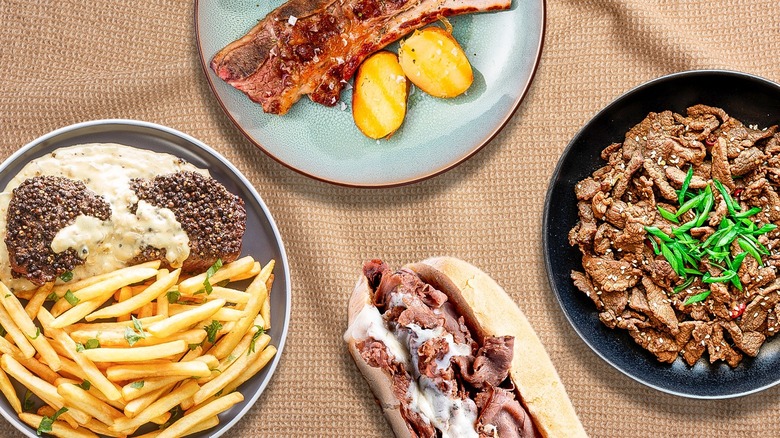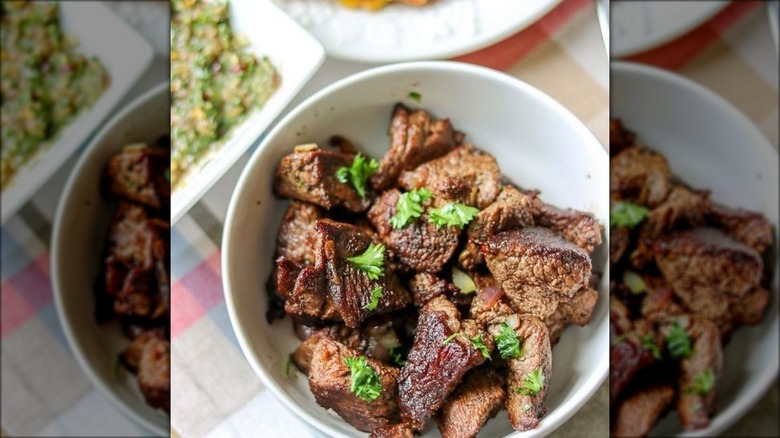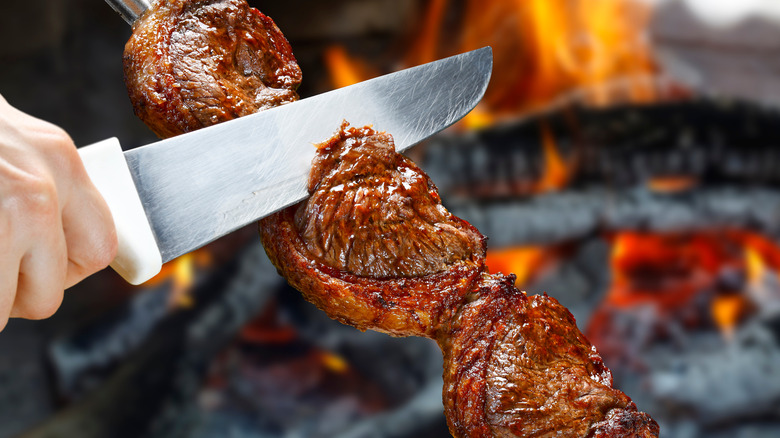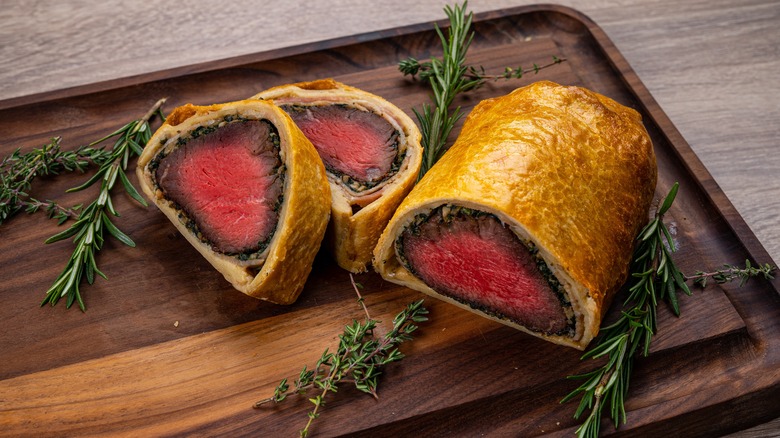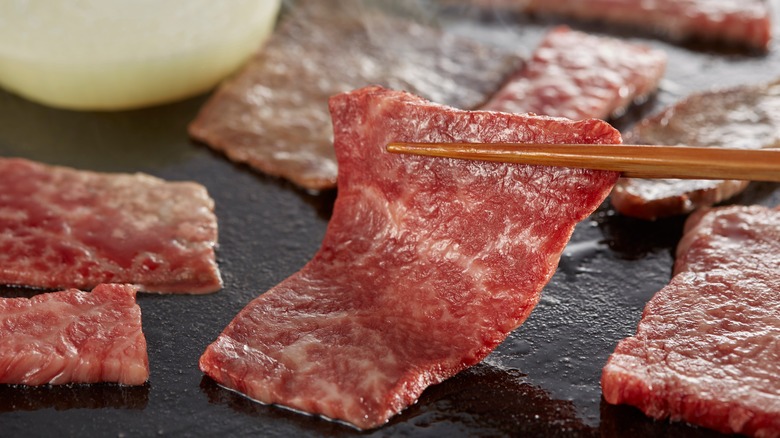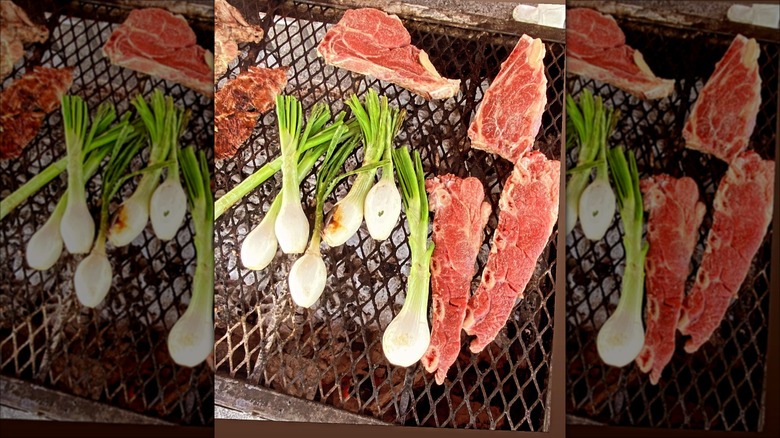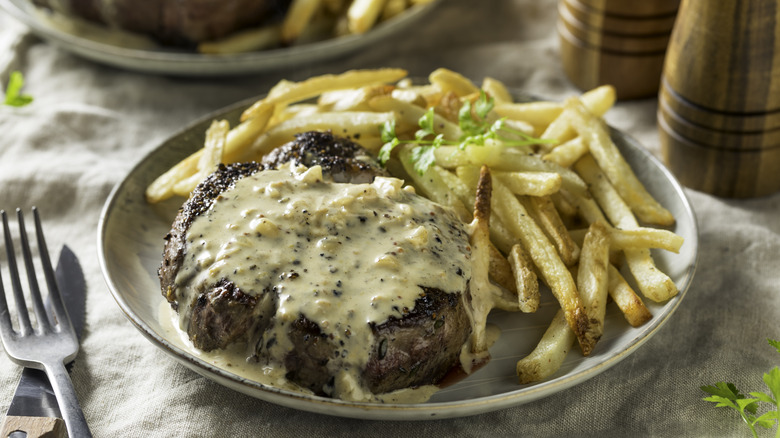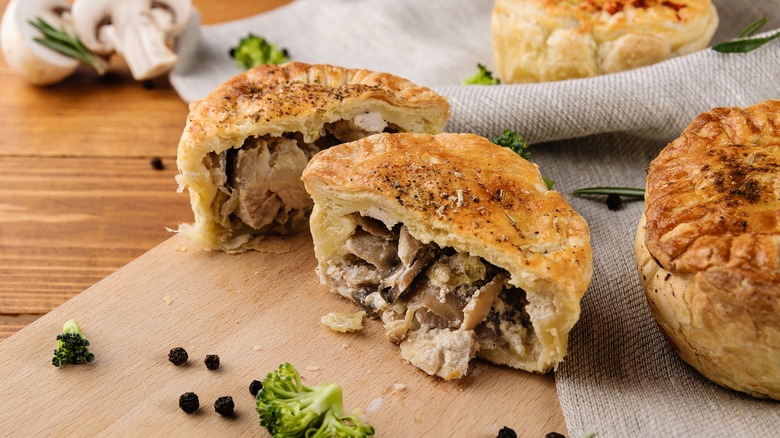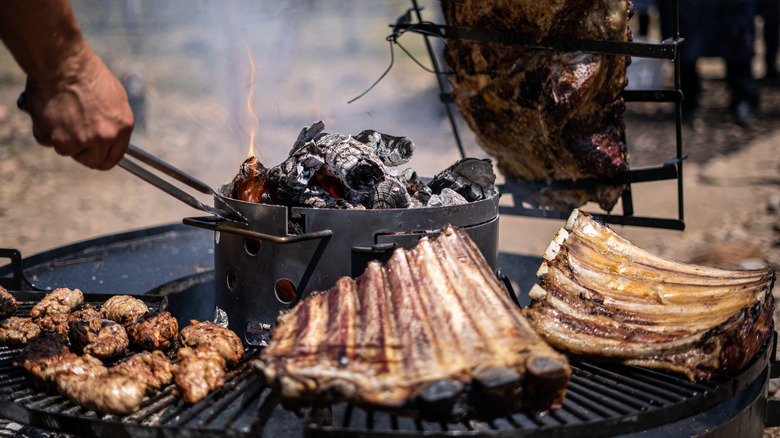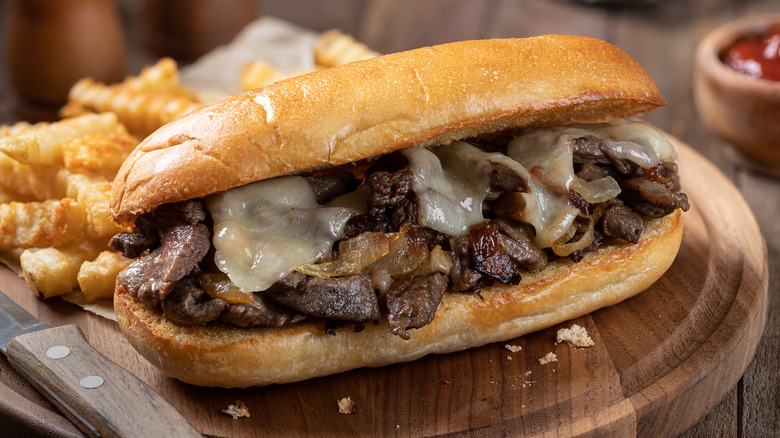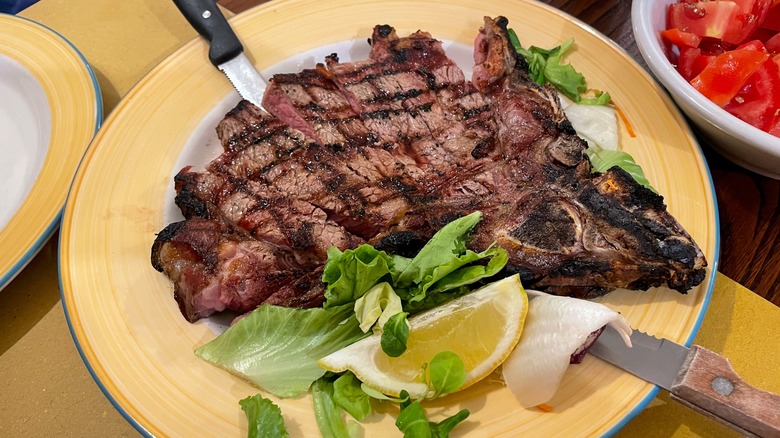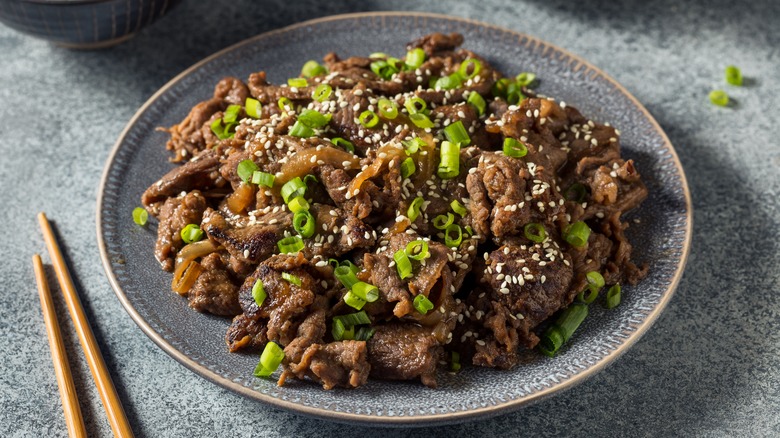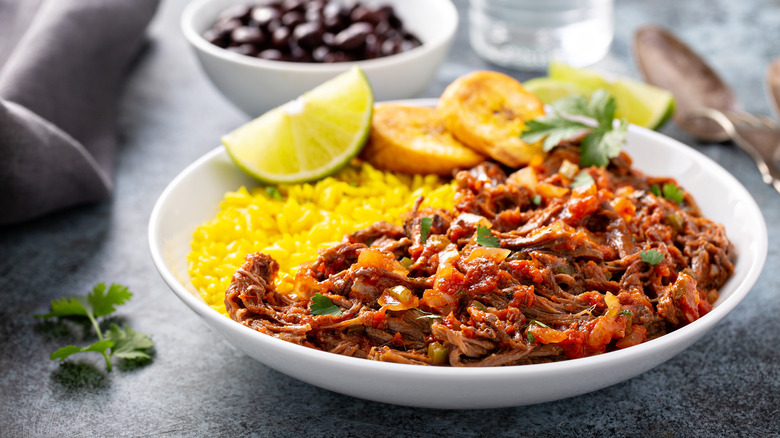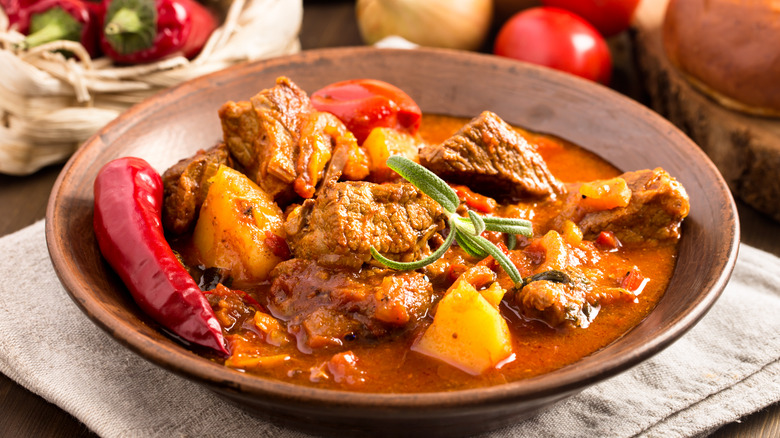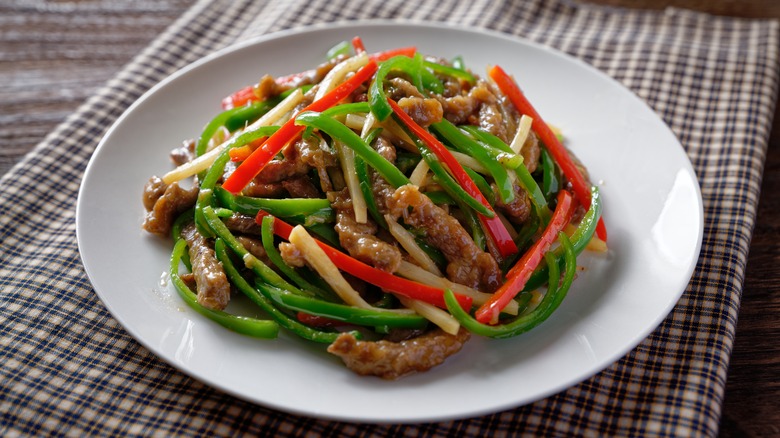14 Popular Steak Dishes From Around The World You Need To Try
When most people think of a hearty and decadent meal, they think of something involving steak. It's one of the most beloved proteins worldwide, thanks to its rich taste and versatility. Moreover, there are many ways to prepare and serve steak, with different countries and cultures using a wide variety of cuts, spices, and cooking techniques to showcase the meat. If you're looking to incorporate some international flair into your steak routine, this article is for you. In an effort to expand our repertoire of steak recipes, we decided to do a deep dive into some of the most popular steak dishes from around the world.
To accomplish this, we spoke with chefs, foodies, and travel experts to find out what their favorite international steak dishes are and how they're prepared. We grilled the experts (pun intended) on what types of steak, seasonings, and methods elevate a simple piece of beef into a world-renowned meal. Their answers are fascinating. The next time you're craving red meat, consider trying one of these global steak dishes. You may just find that you have a new favorite meal.
1. Tasso Beef, Haiti
Tasso beef may not be very well known outside of Haiti, but it's a street food staple and a popular party dish in its island home. Chef Nickenford Joseph of New York City's Vinyl Steakhouse was born and raised in Port-de-Paix, Haiti, and he has fond memories of the dish. He said, "Haitian tasso beef ... consists of steak bites marinated in a blend of spices and then fried. The bold, aromatic spices and crispy texture made it a standout dish in my childhood."
It's relatively easy to make tasso beef at home. To start, you need tender cuts of steak that cook quickly, like sirloin or tenderloin, cut into cubes. Then you marinate the meat in a mixture of orange and lime juice and a flavorful paste called epis, which typically consists of blended or mashed chili peppers, bell peppers, onion, garlic, apple cider vinegar, and fresh herbs like thyme and parsley. Once the beef has marinated long enough to absorb the flavors, the cubes are fried until crispy. Tasso beef is often served with fried plantains or rice and beans.
2. Churrasco, Brazil
If there's one steak dish worth jumping on a plane for, many experts agree it's Brazilian churrasco. Churrasco simply refers to any meat cooked on skewers over flames. More than a few of the experts we spoke to said picanha is their favorite cut for churrasco. Also called a sirloin cap, this cut comes from the rump of the cow and contains a fat cap. Sebastian Garrido of Vibe Adventures, a travel agency based out of Mexico City, said, "I love that picanha has a layer of fat that adds a lot of flavor, leaving you with a cut of meat that's juicy, tender, and buttery."
Chef David Rose of Omaha Steaks said that even modest cuts of meat like skirt, flank, and flap steaks can be truly delicious when cooked churrasco style over an open flame. "These working man/woman steaks are transformed into something phenomenal, juicy, and tasty when cooked correctly," he remarked. "A lot of people are unaware of how to properly cook these cuts, so they shy away from them. Cooked medium-rare and sliced against the grain is the way to go with these steaks!" A bright, tangy chimichurri sauce can also take your churrasco to the next level.
3. Beef Wellington, U.K.
It's hard to think of a more classic British dish than beef Wellington. Named after the Duke of Wellington, it consists of beef tenderloin covered in minced mushrooms and pate, wrapped in puff pastry, and cooked in the oven. Dagan Lynn, executive chef of Beef. It's What's For Dinner, said, "Beef Wellington is always a standout for me. Steak paired with delectable ingredients like foie gras and foraged mushrooms all wrapped up in a flaky delicious dough layered with butter is a knockout combination."
Although beef Wellington can be complicated to make, many experts agree it's worth the effort. Jason Kennedy, in-house meat expert at Verde Farms, offered a few tips for home cooks. He said, "Make sure to get a good sealing sear on the tenderloin (also known as filet mignon) and allow the steak to cool before encasing it in the puff pastry. Also, try rolling the steak into a crepe before the puff pastry to help with crispness and hold in any juice (helps to avoid the pastry from getting wet)." He also noted that with any steak dish (international or otherwise), it's crucial to allow the steak to rest before serving.
4. Yakiniku, Japan
The word yakiniku translates to "grilled meat" in Japanese, but this style of cooking is so much more than just that. Yakiniku is a dining experience that involves cooking meat, seafood, and vegetables on a grill or griddle over fire. Diners typically cook the meat themselves. Beef is often the star of the show, with cuts like sirloin, brisket, and short ribs on offer. It get a further kick of flavor from yakiniku dipping sauce made with soy sauce, mirin, and sesame seeds.
"There's something about the combination of the tender, rich beef with the sweet and savory yakiniku sauce that just melts in your mouth," said Gabrielle Marie Yap, senior editor at Carnivore Style. "I also love the interactive experience of grilling the steak yourself at the table, which adds a fun and social element to the meal. The way the chef carefully selects the finest cuts of meat and presents them with a flourish, the sizzle and aroma of the grill, and the joy of sharing the experience with friends and family — it all comes together to create a truly unforgettable experience." Yap is right: Yakiniku is delicious on its own, but the communal aspect truly takes it to the next level. This makes this style of cooking ideally suited for a celebratory dinner.
5. Aguja norteña, Mexico
Steak is an integral part of Mexican cuisine, especially in the northern states, where there are vast open spaces ideal for raising cattle. You may have heard of carne asada, which translates to "grilled meat." Carne asada can be made with any cut of steak, including arrachera (skirt steak), flap steak, and flank steak. However, if you're in the northeastern state of Nuevo León, aguja norteña is the way to go. The direct translation is "northern needle."
Aguja norteña is a chuck cut that usually contains a thin strip of bone. It's often compared to chuck eye steaks in the States. Sebastian Garrido explained, "It's a thin part of the beef, kind of like a rib but way more soft." These tender cuts are cooked over fire and flipped often to retain the juices. Garrido added, "The preparation is similar to other steaks, but I always use something we call "tomillo," which would be thyme, when marinating it." Like many Mexican meats, aguja norteña is often served with tortillas, salsa, and beans.
6. Steak au poivre, France
Steak au poivre is an iconic French dish, so it should come as no surprise that many classically trained chefs have a soft spot for it. Chef Nickenford Joseph said, "Lately, steak au poivre has been my favorite international steak dish to prepare. This French classic features a steak coated in crushed peppercorns, seared, and then served with a luscious cognac green peppercorn sauce. The sauce's creaminess, combined with the spicy peppercorns and the rich cognac, creates a symphony of flavors that pairs beautifully with a high-quality steak."
Home cooks also love the dish because it's not too complicated to prepare, but offers loads of flavor. The ideal cut of beef for steak au poivre is filet mignon, because it's very tender. However, you can also experiment with other cuts like New York strip or boneless ribeye. The sauce is also key. Many chefs saute shallots, butter, and peppercorns in the pan the steak was cooked in, then deglaze with cognac or brandy and add the cream at the end. This results in a truly heavenly dish bursting with many different flavors.
7. Beef pie, Australia
Ask Aussies what dish they consider quintessentially Australian, and many will tell you it's a good old-fashioned meat pie. As Jason Kennedy said, "Beef pie — reminds me of home in Australia: slow-cooked, tender and flavorful meat and gravy with flaky pastry ... hard to beat!" British settlers brought recipes for meat pies to Australia over 200 years ago, and it's easy to see why they're still popular today. The delicate pastry encases the tender meat and gravy, creating a dish full of delicious texture and flavor. Plus, it's hearty, portable, and easy to eat.
Of course, you can fill an Aussie pie with pretty much anything you desire, like chicken, fish, beef, vegetables, or cheese. However, steak is one of the most common fillings. A classic meat pie could include steak and mushrooms, steak and kidney, or minced beef. The key is to use quality ingredients like a rich, buttery shortcrust for the pastry, slow-cooked cuts like chuck roast for a chunky meat filling, and flavorful ingredients for the gravy like garlic, onions, beef stock, Worcestershire sauce, and tomato paste.
8. Asado, Argentina
Argentina has a long history of cattle ranching, so it should come as no surprise that steak is an integral part of Argentinean culture. Asado was specifically born out of gaucho traditions that date back to the 18th century. At that time, cowboys and ranchers would cook beef with whatever was on hand — mainly salt and fire. The tradition continues today: The term asado refers to the activity of barbecuing meat, the social gathering, and the food itself.
Kylian Goussot, executive chef at Miami's Lafayette Steakhouse, said, "Asado in Argentina is a unique culinary experience where the ritual of preparation and cooking is as important as the meal itself." A traditional asado starts with a fire made with wood. Often, only one person is appointed as the asador, or grill master. That person is responsible for cooking meats like tira de asado (short ribs), flank steak, and tenderloin. Daniel Yohai-Cruz, head of product at Wild Fork, expounded, "Beef is really at the center of everything and minimal seasoning is needed for such flavorful cuts of meat. It's all about selecting the right cuts that are high quality, and cooking [them] to perfection."
9. Philly cheesesteak, U.S.A.
The Philly cheesesteak combines two things Americans love: steak and sandwiches. The dish was invented in the 1930s by a man named Pat Olivieri who ran a hot dog stand close to Philadelphia's Italian Market. One day, Olivieri decided to switch things up and add chopped beef and grilled onions to a hot dog bun instead of a frank. Once cheese got added to this new type of sandwich, the Philly cheesesteak was born. Pat's King of Steaks still serves these iconic sandwiches today.
Anybody can add steak and cheese to a sandwich and call it a cheesesteak. However, the real reason Philly makes the best cheesesteaks comes down to the ingredients. First, you need a roll that is crusty on the outside, but soft and pillowy inside. The steak is also key — only ribeye steak will do, nicely marbled and thinly sliced against the grain. The final touches include chopped onions cooked on the grill and either Cheese Whiz or provolone. Optional ingredients include green bell peppers, mushrooms, and hot cherry peppers.
10. Bistecca alla fiorentina, Italy
If you're dining at an Italian restaurant and happen to see bistecca alla fiorentina on the menu, many experts say you'd be remiss not to try it. Just ask Gabrielle Marie Yap: She said, "A steak dish that I think deserves more recognition is the bistecca alla fiorentina from Tuscany, Italy." Also known as Florentine steak, the dish is essentially steak grilled over flames and seasoned very simply. What makes it so special, then?
Yap explained, "This dish features a T-bone steak from the Chianina cattle breed, one of the oldest cattle breeds in the world. It's traditionally cooked over a wood or charcoal fire and seasoned with just salt, black pepper, and a squeeze of lemon. The result is a steak that's crispy on the outside, but tender and juicy on the inside." Thanks to the lean meat and fine marbling of Chianina beef, this steak is indeed complete without any kind of fancy sauce. Plus, cooking it over fire imparts a unique flavor. Kylian Goussot said, "It's simple but delicious, with grilling that highlights the quality of the meat."
11. Bulgogi, Korea
Korean barbecue may have only recently taken North America by storm, but the culinary tradition dates back about 2,000 years. Many dishes have evolved from this distant origin point, but one of the most popular is definitely bulgogi. A typical bulgogi recipe consists of thinly sliced beef that is marinated in a sweet and savory soy-based sauce. The meat is then either grilled over charcoal or sautéed in a skillet. Additions can include sesame seeds and scallions. Bulgogi is often eaten with rice or rolled up in a lettuce leaf.
The trick for making supremely tasty bulgogi is choosing the right cut of steak. You want something that is tender and has a good balance of fat and lean meat, like ribeye or sirloin. The beef should be sliced as thin as possible so that it soaks up all the marinade and cooks evenly on the grill or skillet. A typical bulgogi marinade contains sweet, salty, and savory elements like soy sauce, ginger, sugar, and sesame oil. It may also contain fruit juices from pears or kiwis to help tenderize the meat. The result is a dish that's beautifully textured and packed with flavor.
12. Ropa vieja, Cuba
The national dish of Cuba has an interesting name that belies its bold flavors. Ropa vieja translates to "old clothes." Legend has it that the dish was born when a poor man was so hungry, he cooked his own tattered clothes. As he cooked, he prayed, and the clothes miraculously transformed into a rich meat stew. The reality is, the name probably comes from the way the shredded beef in the dish looks. Either way, it's a supremely tasty meal that originated in Spain, but got its uniquely Caribbean flavors from Cuba.
Ropa vieja typically consists of a tougher cut of beef, like flank steak. The meat is slow-cooked with a colorful mix of bell peppers, onions, tomatoes, and beef broth, as well as spices like cumin and oregano. Everything is simmered together until the beef is tender enough to shred with a fork. It's typically served with rice and beans and fried plantains, with lime wedges on the side. Chef-in-residence of ButcherBox Ashley Lonsdale says, "A good ropa vieja is irresistible and while maybe more popular in Cuba, you can find it all across the Caribbean. The braised beef melds with sweetness from peppers and onions — it's really magical."
13. Goulash, Hungary
Tons of people can't get enough of Hungarian goulash. As Jason Kennedy said, "I get hungry thinking about it!" Historians believe the dish dates back to the 9th century, and that we have Magyar shepherds to thank for it. They cooked their beef in cauldrons with ingredients they had on hand, like onions, lard, and paprika. Over the centuries, the peasant dish made it into the kitchens of nobility and eventually across the world.
Goulash typically consists of tougher cuts of beef that are slow-cooked with bright ingredients that give it vibrant flavor. These could include tomatoes, bell peppers, garlic, and beef broth. However, goulash also has a touch of smokiness and slight heat from the paprika. A classic Hungarian goulash recipe might also call for caraway seeds, carrots, red wine, and potatoes. Unlike many similar dishes, goulash is typically served in its broth rather than cooked down until it becomes ultra thick. It can be eaten on its own or with crusty bread to sop up the liquid goodness.
14. Pepper steak, China
Pepper steak is the perfect stir-fry dish, packed with tasty strips of marinated steak and bright veggies. As Nickenford Joseph said, "This dish is a delightful blend of savory flavors, incorporating ingredients like soy sauce, honey, and garlic. The peppers add a colorful, crunchy element that compliments the tender beef perfectly. It's a well-balanced dish that brings together sweet, salty, and umami flavors, making it a favorite in my kitchen."
Chinese pepper steak is pretty easy to make at home. To start, you'll need a tender cut of beef like flank steak, cut into strips. There are many different recipes for the marinade, but most include soy sauce and cornstarch (which thickens the marinade up). You can also add ingredients like black pepper, sesame oil, ginger, Shaoxing cooking wine, and honey for extra flavor. Let the meat absorb the flavors, then sauté it with onions and bell peppers. You can also use a slow cooker pepper steak recipe to save time. Pepper steak is often served with rice, which acts as the perfect canvas for its vibrant flavors.
